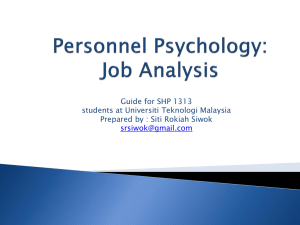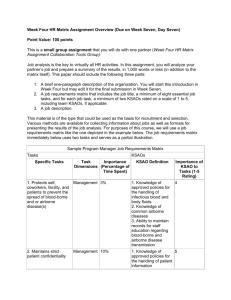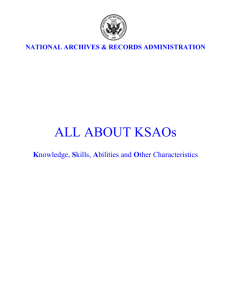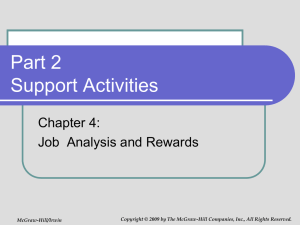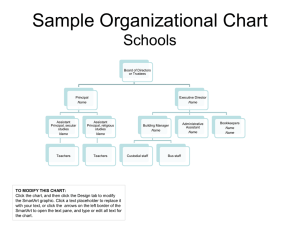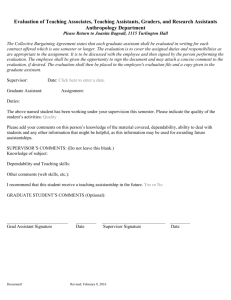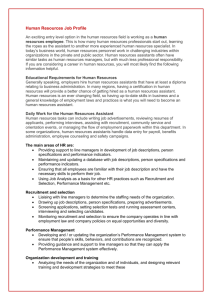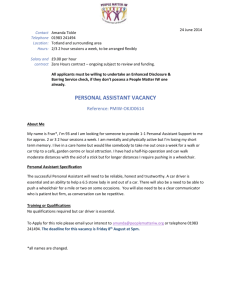Example of a good JA project (Pavisic)
advertisement
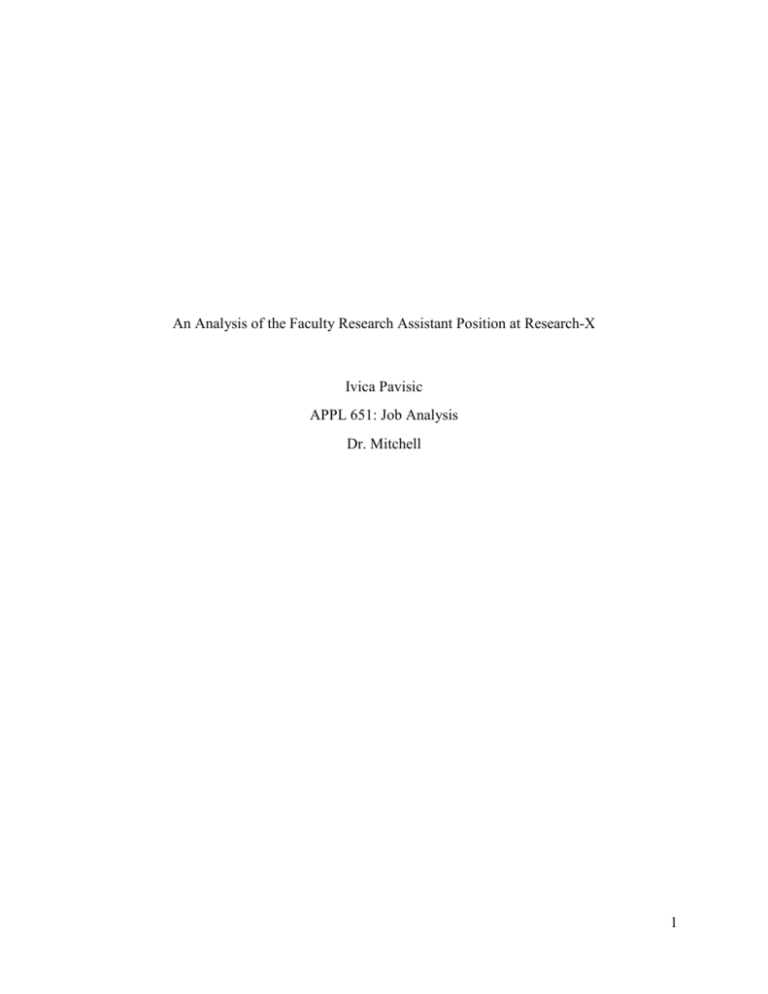
An Analysis of the Faculty Research Assistant Position at Research-X Ivica Pavisic APPL 651: Job Analysis Dr. Mitchell 1 Table of Contents Executive Summary ........................................................................................................................ 3 Introduction ..................................................................................................................................... 4 Method ............................................................................................................................................ 5 Results ............................................................................................................................................. 7 Discussion ....................................................................................................................................... 8 References ..................................................................................................................................... 14 Table 1. Final list of faculty research assistant tasks and task definitions. ................................... 15 Table 2. Faculty research assistant tasks, mean SME scores, standard deviations . ..................... 17 Table 3. Final list of faculty research assistant KSAOs and KSAO definitions. .......................... 18 Table 4. Faculty research assistant KSAOs, mean SME scores, standard deviations .................. 20 Table 5. Linkage table: Knowledge necessary for faculty research assistant tasks. ..................... 22 Table 6. Linkage table: Skills necessary for faculty research assistant tasks. .............................. 23 Table 7. Linkage table: Abilities necessary for faculty research assistant tasks. ......................... 24 Table 8. Linkage table: Other characteristics necessary for faculty research assistant tasks. ...... 25 Table 9. Correlations between importance scores for the ten most important.............................. 26 Appendix A: Task and KSAO creation instructions. .................................................................... 27 2 Executive Summary The following report details a job analysis conducted for the position of faculty research assistant at Research-X. Levine’s (1983) combination job analysis method (C-JAM) was utilized for the purposes of improving selection, assessment, and training procedures. Eleven subject matter experts compiled a list of 30 job tasks and 37 knowledge areas, skills, abilities, and other characteristics (KSAOs) that were relevant to the position. Tasks were rated by SMEs on their difficulty and criticality; these dimensions were added together to produce a measure of task importance. KSAOs were rated on necessity for newly hired employees, practicality that they could be expected on the job market, how likely trouble was if they were ignored during selection, and the extent to which they distinguished superior employees from average ones. The latter two scores were multiplied together to produce a KSAO importance rating. Drafting sections of technical reports, performing statistical analyses, and conducting literature reviews were identified as the most important tasks for a research assistant, while dependability, cooperation, and flexibility were identified as the most important KSAOs. Certain KSAOs—such as clerical knowledge, active learning abilities, and complex problem solving— were identified as being useful for selection criteria, and others—such as knowledge of database management, knowledge of a language other than English, and knowledge of statistical procedures—were identified as useful for future training topics. 3 Introduction Research-X is a Department of Defense university affiliated research center located in X. It is the largest language research center in the United States. At Research-X, applied and theoretical linguists, neuroscientists, anthropologists, and psychologists work together to improve second-language learning, increase the country’s language capabilities, assess different areas of governmental workforce readiness, and solve a number of other critical national issues (University of Maryland, 2013). Research-X currently employs 17 full-time faculty research assistants, and hires roughly three to five of them per year, depending on project needs. Research assistants all have at least a Bachelor’s degree—primarily in a field such as linguistics, psychology, anthropology, or in a specific language. They are supervised by project managers, but are also directed by project principal investigators. A research assistant may be assigned to as few as one project or as many as three, with most typically splitting their time between two. As the scopes of all of ResearchX’s projects are greatly varied, the type of work performed by each research assistant varies depending on the projects to which they are assigned. While it is acknowledged that Research-X’s faculty research assistants perform a wide array of tasks and employ a large set of knowledge, skills, abilities, and other characteristics (KSAOs), a formal analysis has never been performed to determine the specific components of the position. Results from a properly conducted job analysis can be used to improve the validity of selection and assessment tools; further, the procedure provides legal defensibility to these procedures (Brannick, Levine, & Morgeson, 1983; Wilson, 2007), The list of job tasks generated can be used to create a job description and a performance appraisal system. The list of KSAOs 4 identified can be used for selection criteria or to identify training topics. Thus, with the intent of improving Research-X’s selection, assessment, and training procedures, I sought to analyze the position of faculty research assistant. Method Sample This analysis acquired data from 11 subject matter experts (SMEs) for the position of faculty research assistant. Participants included eight faculty research assistants, two project principal investigators, and one project manager. Each participant worked at Research-X in some capacity for at least one year. Procedure The method chosen for this analysis was the combination job analysis method, or CJAM. SMEs were individually asked generate a list of tasks, knowledge, skills, abilities, and other characteristics (KSAOs) that pertained to the job of faculty research assistant. (See Appendix A). Lists of tasks and KSAOs were created by consolidating all individual SME responses, eliminating duplicate entries, and combining similar entries. Although the tasks and KSAOs that went into the final list were all derived entirely from SME input, O*Net descriptions were used as a reference for naming some tasks and KSAOs on the final list. After creating final task and KSAO lists, they were sent back to the same 11 SMEs for them to rate each item on a number of criteria. Measures The C-JAM method, as described by Levine (1983), contains several scoring categories on which SMEs were to independently rate tasks and KSAOs. The scoring values that were used 5 for this job analysis included a Task Difficulty item on a 7-point scale (1 = “one of the easiest tasks of all,” 7 = “one of the most difficult of all tasks”) and a Criticality item on a 7-point scale (1 = “consequences of error are not at all important,” 7 = “consequences are extremely important”). KSAOs were independently rated by each SME. For each KSAO, the extent that trouble was likely if the KSAO were to be ignored in selection (Trouble Likely) was assessed using a five-point scale (1 = “very little/none,” 5 = “to an extremely great extent”), as was the extent that different levels of the KSAO distinguish superior employees from average ones (Distinguish Superior). The necessity of the KSAO for newly hired employees (Necessity) and the practicality of expecting the KSAO in the labor market (Practicality) were captured using yes/no responses. Scoring Data were scored in accordance with the guidelines established by Brannick et al. (1983). Means and inter-rater reliabilities (rWG) were established for each item. For job tasks, the means of Difficulty and Criticality were added together to create the variable Task Importance. Tasks were then ranked from highest scoring to lowest. For KSAOs, the means of Trouble Likely and Distinguish Superior were multiplied together to create the variable KSAO Importance, as per Brannick et al.’s suggestion. In order to be considered for selection, both tasks and KSAOs had to have an rWG value of at least 0.80. KSAOs additionally had to be deemed by a majority of SMEs (i.e., at least six) to be (1) necessary for newly hired workers and (2) practical to expect on the job market. In addition, KSAOs also had to (3) have a score of at least 1.5 for the Trouble Likely variable. Further, those KSAOs that met these three criteria and were also scored greater than 1.5 on Distinguish Superior were considered for development into screening measures that would help 6 rank applicants from most to least qualified. On the other hand, those KSAOs that met the first three criteria but were scored at or below 1.5 on Distinguish Superior were considered for development into pass/fail screening measures. KSAOs that were not deemed necessary for new workers but were rated greater than a 1.5 on Distinguish Superior were considered for training purposes. If the KSAO scored less than or equal to a 1.5 on Practical, then all employees at an organization were suggested to train on it; if it scored greater than a 1.5, then only those employees that were sub-par on it were required to be trained. Once tasks and KSAOs were finalized, SMEs reached a consensus about the relationship between specific tasks and specific KSAOs, putting their results into a linkage table. Results A full, final list of faculty research assistant tasks can be found in Table 1. Mean SME scores, standard deviations, and inter-rater reliability (rWG) values for Task Difficulty and Criticality can be found in Table 2. Only tasks that had an rWG value of over a 0.80 were included on the final list of tasks. According to SMEs, the five most important tasks assigned to faculty research assistants are drafting sections of technical reports, developing project milestones, maintaining databases of project data, performing statistical analyses on data, and maintaining libraries of literature and bibliographic content. A full list of generated KSAOs can be found in Table 4; mean scores, standard deviations, and rWG values for the variables Necessary, Practical, Trouble Likely, and Distinguish Superior can be found in Table 4. Tables 5 through 8 consist of linkage tables between relevant tasks and knowledge, skills, abilities, and other characteristics, respectively. According to SMEs, 7 the five most important KSAOs were dependability, cooperation, flexibility, independence, and time management skills. Correlations between importance scores for tasks and KSAOs according to SMEs can be found in Table 9. Of note, the importance of initiative was found to be positively correlated with the importance of drafting administrative documents, participant recruitment, and building team websites; the importance of achievement was positively correlated with the importance of training; the importance of attention to detail was positively correlated with the importance of building team websites; and the importance of cooperation was positively correlated with the importance of participant recruitment. Discussion The purpose of this job analysis was to determine the tasks, knowledge, skills, abilities, and other characteristics most relevant to the position of faculty research assistant at Research-X. Selection, performance appraisal, and training processes can be improved using this information. According to SMEs, the most important task out of all of those assigned to faculty research assistants was drafting sections of technical reports. This was closely followed by performing statistical analyses on project data, and performing literature reviews—two activities that also serve to provide information to technical reports. The technical report is arguably the most significant deliverable of any project, as it summarizes the progress and results of the work carried out over the course of the fiscal year. Drafting administrative deliverables—such as status reports and fact sheets—and helping develop project milestones and timelines, which are presented as a deliverable to the client at the project’s start, were also rated as highly important. This type of work was discussed by a principal investigator during an interview: 8 “Most other research institutions will have [research assistants] only performing the more menial work, like cleaning data or setting up experimental equipment. At Research-X, we make them do all of that, too, but we also heavily involve them in project planning and in the actual report writing. …They are key players within each project, from start to finish. We expect a lot from them.” Among KSAOs, dependability, cooperation, and independence were ranked as some of the most important, reflecting Research-X’s overall desire for employees that work well within teams while simultaneously performing effectively as individuals. Flexibility and the ability to learn new information were also considered very important, reflecting Research-X’s everchanging work environment. Implications Table 2 enumerates the job tasks associated with faculty research assistants and ranks them by importance. This list may be used as a self-screening tool in the selection process; when future job announcements are created, it can be given to prospective employees so that they may have an accurate depiction of the position. These tasks may also be used in the construction of work sample tests to be used in the selection process. In addition, these tasks, used in conjunction with their importance ratings, can be used to create a performance appraisal measure for existing employees. A graphic rating scale instrument can be made by appending a 7-point Likert type scale (1 = “Unsatisfactory,” 4 = “Average,” 7 = “Outstanding”) to each item to assess an employee’s performance. Each item will 9 be weighted with its Task Importance score, and then added together to produce a total score. All employee total scores can then be compared in order to identify which workers deserve merit pay or promotions and which need retraining or reprimanding. A majority of SMEs identified clerical skills, active learning, complex problem solving, coordination, critical thinking, knowledge of science, time management skills, deductive and inductive reasoning, problem sensitivity, effort, flexibility, analytical thinking, attention to detail, cooperation, dependability, independence, initiative, integrity, intellectual curiosity, and persistence as being necessary for new employees and practical to expect on the job market. Further, different levels of these KSAOs were deemed to distinguish superior employees from average ones, meaning that they may all be used to develop screening measures on which interviewers can rank prospective employees. For example, job-seekers can be given a battery involving questions assessing each of these KSAOs, and each question can be weighted using KSAO Importance scores. Knowledge of the English language, the ability to operate technology, reading comprehension, written and oral communication, speaking ability, and near vision were all determined to be necessary for new employees and practical to expect on the job market, but were not considered to distinguish superior employees from average ones. For these reasons, prospective employees should be screened on a pass/fail basis using these KSAOs; applicants that do not possess one or more of them should not be considered. Because database management, speaking a language other than English, and statistics were all considered to distinguish superior workers from average ones, but were not seen to be necessary for new employees or likely to expect on the job market, training in each of these should be offered to all employees. Research-X has already implemented weekly study groups 10 for each of the languages with which its researchers work, and there is also a weekly statistics work group. In addition to these, a database management training should be offered, perhaps with a focus on the tasks associated with database management, identified in Table 5. Active listening, and knowledge of anthropology, linguistics, and psychology were rated as being able to distinguish superior employees from average ones, unnecessary for new employees, but likely to expect on the job market. For these reasons, trainings in each of these areas should be offered to employees who do not already possess this knowledge. Limitations One limitation to this job analysis was that, while it did provide insights into the job of faculty research assistant, the job is more nuanced in reality. Research assistants’ tasks can vary depending on the projects to which they are assigned. SMEs belonged exclusively to one of three different Research-X projects, which were based in two different fields of research—linguistics and psychology. For this reason, there was low inter-rater reliability on 12 of the 30 job tasks identified. The disagreed-upon tasks were almost all specific to only one of the projects; for example, those working on the psychological project often had to travel to client meetings, and thus rated this task to be very critical to the faculty research assistant position. Research assistants on the linguistic projects, however, never had to meet face-to-face with their clients, and thus gave this task a low criticality rating. In addition, while it was possible to determine the importance of each job task associated with the job, SMEs were reluctant or unable to provide information about the average amount of time faculty research assistants spend performing each task, citing major variations in the proportions of their duties, depending on a number of factors. The following is a quote from one of the SMEs: 11 “I’ve been here for over a year, and I don’t think it’s possible for me to tell you what I’ll be doing during any given week. …So much is dependent on which projects you’re on, where those projects are in terms of their deliverables schedule, and what your skills are.” From another SME: “There have been weeks where I’ve done nothing but scan articles into [the computer system], and there have been weeks where I’ve done nothing but write chunks of tech reports. There really isn’t a ‘typical week’ here.” The fact that flexibility was among the three most important KSAOs speaks to these points, which serve to provide further justification to stress the need for this characteristic to prospective employees. While this analysis does not address tasks specific to individual projects, it should be noted that Research-X’s projects change drastically from year to year, and research assistants often switch projects or split their time between two projects. Thus, this job analysis is still of real value, as it identifies the tasks and KSAOs that are necessary to a range of projects. Regardless of what a research assistant’s assigned project, it very likely that he or she will spend time performing the tasks and using the KSAOs listed here. Future Directions As stated previously, work performed at Research-X is dynamic. Each year, many old projects end or are renewed with a changed scope, and new projects are created. For this reason, a job analysis for faculty research assistants should be carried out annually to ensure that general 12 job tasks and KSAOs are accurate and up-to-date. Additionally, job analyses for the rest of the research staff—principal investigators and research scientists—should be conducted to better understand how the entire research team functions and how it should be assessed. 13 References Brannick, M. T., Levine, E. L., & Morgeson, F. P. (2007). Job and Work Analysis: Methods, research, and applications for human resources management. 2nd ed., Sage pub. Levine, E. L. (1983). Everything you always wanted to know about job analysis. Tampa, FL: Mariner. National Center for O*NET Development. (2014). 41-4012.00. O*NET OnLine. Retrieved February 11, 2014, from http://www.onetonline.org/link/summary/41-4012.00 Wilson, M. (2007). A history of job analysis. In L. Koppes (Ed.), Historical perspectives in industrial and organizational psychology (Ch. 9). Mahwah, NJ: Lawrence Erlbaum Associates. 14 Table 1. Final list of faculty research assistant tasks and task definitions. Task Definition 1. Draft TR sections Draft assigned sections of technical reports 2. Develop milestones Aid the rest of the team in the development and maintenance of project milestones, timelines, and deadlines 3. Maintain databases Create, clean, and maintain databases containing project-related quantitative data 4. Statistical analysis Engage in qualitative or quantitative statistical analysis using SPSS, R, or other electronic statistical packages 5. Maintain libraries Maintain document libraries, archives, and bibliographic lists 6. Literature review Aid in locating, summarizing, and cataloging relevant research articles as part of the literature review process 7. Participant recruitment Recruit participants for studies by using flyers, listserv posts, or meeting in-person 8. Training Attend relevant trainings and reading groups to learn and enhance project-specific knowledge and skills 9. IT tickets Place online tickets and coordinate with IT staff for IT needs 10. Draft admin documents Draft project-related materials such as grant proposals, institutional review board (IRB) documents, fact sheets, and status reports 11. Build team website Create and maintain internal project website using Microsoft SharePoint 12. Schedule meetings Schedule team and client meetings online using Microsoft Outlook 13. Draft agendas Collect items for meeting agendas from other teammates and use them to create agenda drafts 14. Record minutes Record minutes during team and client meetings, and distribute them to the team after the meeting in a timely manner 15. Attend meetings Attend weekly team meetings and contribute to team conversations 16. Scan materials Scan relevant books, articles, and other hard-copy materials into the computer network for digital storage 17. Library duties Pick up and return items from the University of Maryland campus library for other teammates 18. Create presentations Create presentation materials with Microsoft PowerPoint, using notes from teammates 19. Proofread deliverables Review technical reports, linguistic manuscripts, and other deliverables for spelling, grammar, and formatting errors 20. Run audio recorder Run audio recording equipment to capture participant data 15 21. 22. 23. 24. Transcribe audio Test speech systems Translate passages Compile lists 25. Travel 26. Compile grammar data 27. 28. 29. 30. Inf. consent / debriefing Set up video conferences Creating language maps Present to clients Transcribe audio at various levels of detail (phonetic, phonemic, etc.) Create key word lists to test automatic speech recognition systems in various languages Translate passages of text from non-English languages into English Compile lists of linguistic features within languages of interest (i.e., pragmatic markers, high frequency lexemes) Travel off-site to client meetings Compile data for grammar analysis by copying and pasting blocks of text from current news articles and blog posts written in languages of interest Read informed consent and debriefing materials to study participants before and after experiments Set up necessary equipment for video conferencing with out-of-state clients Using mapping software to map language dialects onto geographic locations Aid in presentation of research findings to clients 16 Table 2. Faculty research assistant tasks, mean SME scores, standard deviations, and rWG values (N = 11). Difficulty Criticality Task Importance Task M SD rWG M SD rWG Draft TR sections 6.45 1.29 0.83* 5.45 0.93 0.91* 11.91 Statistical analysis 5.18 1.33 0.82* 6.45 1.29 0.83* 11.64 Literature review 6.73 0.65 0.96* 4.64 0.92 0.91* 11.36 Set up video conferences 5.55 2.42 0.40 5.55 2.42 0.40 11.09 Test speech systems 5.36 2.50 0.36 4.82 2.75 0.23 10.18 Draft admin documents 3.55 0.82 0.93* 6.64 0.92 0.91* 10.18 Create presentations 3.55 0.82 0.93* 6.64 0.81 0.93* 10.18 Develop milestones 4.64 0.67 0.95* 5.45 0.93 0.91* 10.09 Participant recruitment 4.55 0.93 0.91* 5.55 1.04 0.89* 10.09 Training 4.83 0.47 0.98* 4.92 0.40 0.98* 9.75 Build team website 4.82 0.40 0.98* 4.91 0.30 0.99* 9.73 Proofread deliverables 3.55 0.69 0.95* 5.82 0.40 0.98* 9.36 Attend meetings 4.73 1.62 0.73 4.27 1.90 0.78 9.00 Run audio recorder 4.91 1.64 0.73 4.00 2.45 0.39 8.91 Maintain libraries 4.27 0.47 0.98* 4.55 1.21 0.85* 8.82 Travel 4.64 2.06 0.57 4.18 2.27 0.47 8.82 Creating language maps 4.18 1.60 0.74 4.45 1.63 0.73 8.64 Maintain databases 3.64 0.67 0.95* 4.36 0.50 0.97* 8.00 Translate passages 3.91 1.70 0.71 3.64 1.75 0.69 7.55 Compile grammar data 4.09 1.58 0.75 3.45 1.81 0.67 7.55 Transcribe audio 3.91 1.70 0.71 3.45 1.63 0.73 7.36 Draft agendas 4.00 0.77 0.94* 3.27 0.65 0.96* 7.27 Compile lists 3.73 1.79 0.67 3.27 2.00 0.59 7.00 Present to clients 3.00 1.55 0.76 3.36 1.80 0.67 6.36 Record minutes 2.55 0.93 0.91* 3.73 0.65 0.96* 6.27 Schedule meetings 2.45 0.93 0.91* 3.45 1.21 0.85* 5.91 Inf. consent/debriefing 3.09 1.81 0.66 2.73 1.56 0.75 5.82 Scan materials 1.45 0.69 0.95* 3.00 0.45 0.98* 4.45 Library duties 1.18 0.40 0.98* 3.18 0.40 0.98* 4.36 IT tickets 1.36 0.67 0.95* 2.27 0.65 0.96* 3.64 Note: Tasks have been rearranged based on task importance, from greatest to smallest. Asterisks mark rWG values over .80, which signify an acceptable level of inter-rater agreement across SMEs. Difficulty was measured on a 7-point scale (1 = “one of the easiest tasks of all,” 7 = “one of the most difficult of all tasks”). Criticality was also measured on a 7-point scale (1 = “consequences of error are not at all important,” 7 = “consequences are extremely important”). Task Importance was calculated by summing the scores of Difficulty and Criticality; the lowest possibly score was 2, and the highest possible score was 14. 17 Table 3. Final list of faculty research assistant KSAOs and KSAO definitions. KSAO Definition Knowledge 1. Anthropology Knowledge of the basic tenets of anthropology, such as societal trends, ethnicity, cultures and their histories and origins 2. Clerical Knowledge of administrative procedures such as word processing, copying, scanning, and managing files and records 3. Database management Knowledge of database management 4. English language Knowledge of the English language 5. Language other than Knowledge of a language other than English, such as Persian, Arabic, or Bangla English 6. Linguistics Knowledge of the basic tenets of linguistics, such as composition and communication 7. Operate technology Knowledge of the use of relevant technology, such as telephones, computers, and different software packages 8. Psychology Knowledge of the basic tenets of psychology, such as the principles of cognitive and cultural psychology 9. Statistics Knowledge of basic statistical techniques and their applications Skills 10. Active learning Understanding the implications of new information for both current and future problem-solving and decision-making 11. Active listening Skills in active listening, or paying attention to and understanding clients’ and teammates’ perspectives 12. Complex problem Solving 13. Coordination 14. Critical thinking 15. Reading comprehension 16. Science 17. Speaking Identifying complex problems and reviewing related information to develop and evaluate options and implement solutions Skills in coordination with clients and coworkers Using logic and reasoning to identify the strengths and weaknesses of alternative solutions, conclusions or approaches to problems Skills in reading comprehension Using scientific rules and methods to solve problems Skills in conveying information effectively and in an engaging way 18 KSAO 18. Time management 19. Writing Abilities 20. Deductive reasoning 21. Inductive reasoning 22. Learn new information 23. Near vision 24. Oral communication 25. Problem sensitivity 26. Written communication Other characteristics 27. Achievement/Effort 28. Adaptability/Flexibility 29. Analytical thinking 30. Attention to detail 31. Cooperation 32. Dependability 33. Independence 34. Initiative 35. Integrity 36. Intellectual curiosity 37. Persistence Definition Skills in time management Skills in writing, both by hand and via computer Ability to apply general rules to specific problems to produce answers that make sense Ability to combine pieces of information to form general rules or conclusions (includes finding a relationship among seemingly unrelated events) Ability to learn new information, such as different languages or the use of different statistical packages Ability to see details at close range Ability to effectively communicate with others in person or over the phone Ability to recognize when a problem may occur or is occurring Ability to effectively communicate with others in writing Establishing and maintaining personally challenging achievement goals and exerting effort toward mastering tasks Being open to change (positive or negative) and to considerable variety in the workplace Analyzing information and using logic to address work-related issues and problems Being careful about detail and thorough in completing work tasks Being pleasant with others on the job and displaying a good-natured, cooperative attitude Maintaining a high level of responsibility and reliability Developing one's own ways of doing things, guiding oneself with little or no supervision, and depending on oneself to get things done Being willing to take on responsibilities and challenges Being ethical and honest in dealing with others Possessing the desire to learn more about relevant topics Being persistent in the face of obstacles 19 Table 4. Faculty research assistant KSAOs, mean SME scores, standard deviations, and rWG values (N = 11). Necessary Practical Trouble Likely Distinguish Superior KSAO M SD M SD M SD rWG M SD rWG Dependability 0.91 0.30 0.64 0.50 3.73 0.47 0.95* 4.91 0.30 0.98* Cooperation 0.91 0.30 0.91 0.30 3.73 0.65 0.90* 4.73 0.65 0.90* Adaptability/Flexibility 0.91 0.30 1.00 0.00 3.55 0.69 0.89* 4.91 0.30 0.98* Independence 0.82 0.40 0.73 0.47 3.55 0.69 0.89* 4.82 0.40 0.96* Time management 0.91 0.30 0.82 0.40 4.55 0.82 0.85* 3.73 0.65 0.90* Learn new information 0.91 0.30 0.82 0.40 3.73 0.47 0.95* 3.82 0.40 0.96* Attention to detail 0.82 0.40 0.82 0.40 3.64 0.67 0.90* 3.91 0.30 0.98* Achievement/Effort 1.00 0.00 0.91 0.30 3.55 0.69 0.89* 3.82 0.40 0.96* Initiative 0.91 0.30 0.73 0.47 2.73 0.65 0.90* 4.73 0.65 0.90* Critical thinking 0.73 0.47 0.91 0.30 3.09 0.54 0.93* 4.00 0.45 0.95* Language other than English 0.18 0.40 0.18 0.40 2.65 1.63 0.73 4.60 0.40 0.96* Science 0.91 0.30 0.82 0.40 3.18 0.75 0.87* 3.73 0.65 0.90* Coordination 0.82 0.40 0.91 0.30 4.00 0.45 0.95* 2.91 0.30 0.98* Clerical 0.91 0.30 1.00 0.00 3.36 0.67 0.90* 3.27 0.65 0.90* Psychology 0.18 0.40 0.82 0.40 2.63 1.80 0.67 4.00 0.45 0.95* Active learning 0.91 0.30 1.00 0.00 2.82 0.60 0.92* 3.00 0.45 0.95* Complex problem solving 0.91 0.30 0.91 0.30 2.27 0.65 0.90* 3.64 0.67 0.90* Persistence 0.91 0.30 0.82 0.40 2.82 0.40 0.96* 2.73 0.79 0.86* Integrity 0.91 0.30 0.91 0.30 2.00 0.77 0.86* 3.82 0.75 0.87* Intellectual curiosity 0.91 0.30 0.91 0.30 1.73 0.47 0.95* 4.09 0.54 0.93* Statistics 0.18 0.40 0.18 0.40 1.45 1.21 0.85* 4.82 0.40 0.96* Active listening 0.18 0.40 0.82 0.40 2.36 0.92 0.80* 2.82 0.75 0.87* Analytical thinking 0.91 0.30 1.00 0.00 1.91 0.54 0.93* 3.27 0.47 0.95* Inductive reasoning 0.82 0.40 0.91 0.30 2.27 0.79 0.86* 2.73 0.47 0.95* English language 0.82 0.40 0.91 0.30 4.64 0.92 0.80* 1.27 0.65 0.90* Problem sensitivity 1.00 0.00 0.91 0.30 2.18 0.75 0.87* 2.64 0.67 0.90* Reading comprehension 0.91 0.30 0.82 0.40 3.64 0.67 0.90* 1.45 0.93 0.91* Linguistics 0.18 0.40 0.91 0.30 1.36 0.67 0.95* 3.73 0.65 0.90* KSAO Importance 18.31 17.64 17.43 17.11 16.97 14.25 14.23 13.56 12.91 12.36 12.35 11.86 11.64 10.99 10.52 8.46 8.26 7.70 7.64 7.08 6.99 6.66 6.25 6.20 5.89 5.76 5.28 5.07 20 Necessary Practical Trouble Likely Distinguish Superior KSAO Importance KSAO M SD M SD M SD rWG M SD rWG Deductive reasoning 0.91 0.30 1.00 0.00 2.36 0.67 0.90* 2.09 0.54 0.93* 4.93 Written communication 0.91 0.30 0.82 0.40 3.27 0.65 0.90* 1.45 0.93 0.91* 4.74 Speaking 0.91 0.30 0.91 0.30 3.18 0.75 0.87* 1.45 0.82 0.93* 4.61 Operate technology 0.82 0.40 0.91 0.30 2.82 0.75 0.87* 1.45 0.69 0.95* 4.09 Anthropology 0.18 0.40 0.91 0.30 1.45 0.82 0.85* 2.73 0.47 0.95* 3.96 Oral communication 0.82 0.40 1.00 0.00 3.09 0.54 0.93* 1.27 0.90 0.92* 3.92 Database management 0.18 0.40 0.09 0.30 1.36 0.67 0.90* 2.82 0.40 0.96* 3.84 Writing 0.00 0.00 0.91 0.30 2.64 0.67 0.90* 1.45 0.82 0.93* 3.83 Near vision 0.91 0.30 0.91 0.30 2.64 0.50 0.94* 1.27 0.47 0.95* 3.35 Note: : KSAOs have been rearranged based on KSAO importance, from greatest to smallest. Asterisks mark rWG values over .80, which signify an acceptable level of inter-rater agreement across SMEs. Necessity was rated on a two-point scale (0 = “not necessary for new employees,” 1 = “necessary for new employees.” Practicality was also rated on a two-point scale (0 = “not practical to expect in the labor market,” 1 = “practical to expect in the labor market”). The extent that trouble was likely if the KSAO were to be ignored in selection (Trouble Likely) and the extent that different levels of the KSAO distinguish superior employees from average ones (Distinguish Superior) were both assessed using a five-point scale (1 = “very little/none,” 5 = “to an extremely great extent”). KSAO importance was determined by multiplying Trouble Likely and Distinguish Superior scores for a particular KSAO, and then dividing that value by the summed importance scores for every KSAO. 21 Table 5. Linkage table: Knowledge necessary for faculty research assistant tasks. Knowledge Database English Tasks Anthropology Clerical management language Linguistics Draft TR sections ● ● ● ● Statistical analysis ● Literature review ● ● ● Draft admin documents ● ● Create presentations ● ● Participant recruitment ● Develop milestones ● ● Build team website ● ● Training ● ● ● Proofread deliverables ● Maintain libraries ● ● ● Maintain databases ● ● ● Draft agendas ● Record minutes ● ● Attend meetings ● Schedule meetings ● Scan materials ● Library duties ● ● IT tickets ● Note: Only tasks and KSAOs with rWG values of at least .80 are included on the linkage tables. Operate technology ● ● ● ● ● ● Statistics ● ● ● ● ● ● ● ● ● ● ● 22 Table 6. Linkage table: Skills necessary for faculty research assistant tasks. Skills Active learning Active listening Complex prob. solving ● ● Coord. Critical thinking Reading comp. Science Tasks Draft TR sections ● ● ● ● Statistical analysis ● Literature review ● ● Draft admin documents ● Create presentations ● Participant recruitment ● ● Develop milestones Build team website Training ● Proofread deliverables ● ● Maintain libraries Maintain databases Draft agendas ● ● Record minutes ● Attend meetings ● ● ● ● Schedule meetings ● Scan materials Library duties IT tickets Note: Only tasks and KSAOs with rWG values of at least .80 are included on the linkage tables. Speaking ● ● ● ● ● ● Time man. ● ● ● ● ● ● ● ● ● ● ● ● ● ● ● ● ● ● ● Writing ● ● ● ● ● ● ● ● ● ● 23 Table 7. Linkage table: Abilities necessary for faculty research assistant tasks. Abilities Deductive Inductive Learn new Near vision Oral comm. Tasks reasoning reasoning information Draft TR sections ● ● ● Statistical analysis ● Literature review ● ● ● ● Draft admin documents ● Create presentations ● Participant recruitment ● Develop milestones ● Build team website ● Training ● ● ● ● ● Proofread deliverables ● Maintain libraries ● Maintain databases ● Draft agendas ● Record minutes ● Attend meetings ● ● Schedule meetings ● Scan materials Library duties ● IT tickets ● Note: Only tasks and KSAOs with rWG values of at least .80 are included on the linkage tables. Problem sensitivity ● ● Written comm. ● ● ● ● ● ● ● ● ● ● 24 Table 8. Linkage table: Other characteristics necessary for faculty research assistant tasks. Other characteristics Achiev. Adapt. Anal. Att. to Coop. Depend. Indep. Initiative Tasks /Effort /Flex. thinking detail Draft TR sections ● ● ● ● ● ● ● Statistical analysis ● ● ● ● ● ● Literature review ● ● ● ● ● ● Draft admin documents ● ● ● Create presentations ● ● ● ● Participant recruitment ● ● Develop milestones ● Build team website ● ● Training ● ● ● Proofread deliverables ● ● Maintain libraries ● ● ● Maintain databases ● ● ● Draft agendas ● ● Record minutes ● ● Attend meetings ● ● Schedule meetings ● ● Scan materials Library duties ● ● IT tickets Note: Only tasks and KSAOs with rWG values of at least .80 are included on the linkage tables. Integrity ● ● ● Intel. curiosity ● ● ● Persistence ● ● ● ● ● ● ● ● ● ● ● ● ● 25 Table 9. Correlations between importance scores for the ten most important faculty research assistant tasks and KSAOs, as rated by SMEs (N = 11). KSAOs Depend. Cooperation Adapt./ Flex. Indep. Time man. Learn new info. Att. to detail Achieve./ Effort Initiative Crit. thinking Draft TR sections -0.16 0.19 0.11 -0.40 -0.37 0.37 0.01 -0.36 0.07 -0.30 Statistical analysis -0.37 -0.21 -0.39 -0.14 -0.01 -0.15 -0.06 -0.34 -0.10 -0.36 Literature review 0.12 -0.18 0.16 -0.03 0.07 -0.29 0.59 -0.07 0.19 -0.06 Draft admin documents -0.16 0.22 0.37 0.43 -0.41 0.17 0.12 0.13 0.68* -0.23 Create presentations 0.35 -0.01 -0.08 0.23 0.09 -0.25 -0.17 -0.38 -0.39 -0.23 Develop milestones 0.12 0.29 -0.04 -0.13 0.19 -0.09 -0.04 -0.53 -0.49 -0.43 Participant recruitment -0.28 0.65* 0.21 -0.25 -0.32 0.37 0.44 0.22 0.79** -0.49 Training 0.11 -0.15 -0.52 -0.35 0.34 0.02 0.39 0.62* 0.23 -0.16 Build team website -0.08 0.34 0.00 -0.19 -0.31 0.08 0.64* 0.25 0.61* -0.42 Proofread deliverables 0.05 -0.23 -0.35 0.45 0.14 -0.55 0.12 -0.08 0.21 -0.27 Tasks Note: * = p<.05; ** = p<.01 26 Appendix A: Task and KSAO creation instructions. Job Analysis: Research Assistant In this exercise, you will create two lists—one of the tasks that a Research Assistant carries out on the job, and one of the KSAOs (knowledge, skills, abilities, and other characteristics) associated with Research Assistants. Additionally, you will receive a survey in the coming weeks in which you will be asked to rate each task and KSAO on a few different dimensions. Before you begin, take a moment to think about a Research Assistant’s typical day of work, the tools and techniques they must use, etc. The lists you create do not have to be exclusive to only your specific job; as you write, think of Research Assistants working in environments similar to the one in which you work. If you have any questions along the way, please email me at ivica.pavisic@gmail.com, and I will get back to you as soon as possible. Thanks again! 1. Creating task statements. List as many task statements as you can (aim for 40-50). A task is an activity that you perform at work. The form in which task statements should be written is as follows: 1. There is an implied subject of the task sentence—namely, workers, employees, or managers. The implied subject is plural, not singular. 2. There is a verb that tells what function the employees are performing. 3. The object of the verb may be data, people, or machines, equipment, work aids, or tools. 4. There is a phrase starting with the word “to” or the words “in order to” that gives the purpose of the worker’s activity. This may be left out, however, if the purpose is obvious. In general, try to be as detailed as you can be. Some examples: For personnel testing specialists: o Write multiple-choice test items for particular jobs to evaluate applicant qualifications. o Ask/answer questions and provide information to applicants to resolve applicant appeals/complaints about test scores. For computer operators: o Forward e-mail to distribution lists to pass information from a single worker to a specified group of workers. o Replace paper and cartridges in printers. For clerks: o Fold, assemble, and staple papers. 27 o Check documents for accuracy. TASK LIST 2. Employee knowledge, skills, abilities, and other characteristics (KSAOs). List as many as you can (aim for 40-50 total). Employee attributes needed to perform the tasks generated in part 1 may be grouped into types of knowledge, skills, abilities, and other characteristics. A knowledge is the degree to which employees have mastered a technical body of material directly involved in the performance of a job. A skill is the capacity to perform tasks requiring the use of tools, equipment, and machinery. An ability is the capacity to carry out physical and mental acts required by a job’s tasks where the involvement of tools, equipment, and machinery is not a dominant factor. Other characteristics are interests, values, temperaments, and personality attributes suggesting what an employee is likely to do rather than how well an employee can do at peak performance. Don’t worry about being too picky regarding whether an attribute is a skill, ability, or other characteristic. For example, ‘flexibility’ might be considered an other characteristic, or it might be “the ability to alter one’s behavior to meet unforeseen circumstances.” As you are developing this list, think about the job of research assistant as a whole. Again, think about the work you do. One approach to generating this list might be to create a corresponding KSAO for each of the tasks you outlined above. For example, for the task “Proofreads and edits reports prepared by the project’s Principal Investigator,” a corresponding KSAO might be “Knowledge of word processing software, such as Microsoft Word.” Some examples: For personal testing specialists: o Knowledge of test item construction principles. o Ability to communicate orally with confused or angry applicants. For water and fuels analysts in an electric power plant: o Ability to work in standing, walking positions for long periods of time. o Willingness to work unusual work schedules. 28 For clerks: o Ability to read names and numbers. o Skill in operating equipment such as an electric staple gun or handheld calculator. KSAO LIST 29
